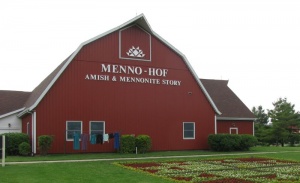Lagrange-Elkhart Old Order Amish Settlement (Indiana, USA)
1956 Article
Elkhart-Lagrange County in 1955 consisted of 24 Amish districts with a membership of circa 1,850, was founded in 1841 by settlers from Somerset County, Pennsylvania, and Holmes County, Ohio, who settled first in Clinton Township about 5 miles (8 km) east of Goshen, then in Newberry Township in Lagrange County, about 15 miles farther east. The first preacher was Joseph Miller, one of the very first settlers, who was ordained bishop in 1848. The second preacher was Isaac Schmucker from Holmes County, Ohio, who arrived the same year and was ordained as the first Amish bishop in Indiana (1843). The settlement spread eastward until in the 1950s it occupied an almost solid block 12 x 25 miles. In the early 1860s a split occurred between the Old Order and the more progressive elements. The latter group began to build meetinghouses and ultimately formed a part of the Indiana-Michigan Amish Mennonite Conference, 1888-1915, organized chiefly in the Clinton Frame and the Forks congregations. About 1855 another Amish group from Fairfield County, Ohio, settled near Topeka (Maple Grove congregation), joining the progressive conference group.
In the 1890s another group broke off, forming the Griner Conservative Amish Mennonite group. In 1945 still another group broke off to form the Burkholder Amish Mennonite group. In 1955 the descendants of the original Amish settlement constituted a total of at least 4,000 members in the area east of Goshen, of whom about 1,600 remained true to the Old Order pattern, maintaining rigidly the older forms of worship, costume, and home life. They still used the Pennsylvania-German dialect, and rigidly rejected modern conveniences such as automobiles, telephones, gasoline engines, and electricity. Next to the Holmes County (Ohio) and the smaller Lancaster County (Pennsylvania) areas, it is the largest Old Order Amish settlement in North America.
The smaller Amish settlement around Nappanee, some 25-30 miles southwest of the Clinton settlement, had a different origin and had little connection with the latter. -- Harold S. Bender
1990 Update
Lagrange-Elkhart, in northern Indiana was founded in 1841 when four Amish families from Somerset County, Pennsylvania, moved onto newly acquired farms southeast of the village of Goshen. The Lagrange-Elkhart community was populated almost exclusively by Amish migrations from Holmes (Ohio) and Somerset Counties. Settlement of this large community resulted in an interesting pattern of grouping with Pennsylvania families locating in the Lagrange County area while Ohio Amish were concentrated in Elkhart County. The two communities differed in degrees of "progressiveness" but remained in full fellowship. Even so, differences persisted after 140 years in areas such as rubber-tire buggies, English Bible study and the general degree of modernity.
Nearly one-third of Amish youth leave the community and generally affiliate with Mennonite and related church groups. All Mennonite churches east of Goshen are heavily populated by first- or second-generation former Amish. Additionally, most members of the seven Conservative Mennonite and four Beachy Amish Mennonite congregations in the area are former Old Order Amish. Even with this attrition rate, the Lagrange-Elkhart community continues to grow. In 1986 it had 65 church districts (congregations) with an overall population of about 10,000. Growth of the community is mainly to the east and north, reaching into Michigan. 1980 census figures showed that more than one-fourth of Lagrange County population was Amish.
Shipshewana, located in the heart of the Amish settlement, with its weekly auctions and 30-acre flea market draws over a million visitors each year. With the influx of tourists, have come craft shops and roadside fruit and vegetable stands to accommodate the busloads of visitors. Menno-Hof, a large visitor center, provides the tourist a leisurely step back through the centuries of Anabaptist history and tells the story of Amish and Mennonite faith in action. Other towns serving this large Amish population are: Middlebury, Millersburg, Topeka, Emma, Honeyville, and Lagrange. In 1987 Honeyville boasted the only area public school with nearly 100 percent Amish enrollment. The Amish community supported about 30 private elementary schools.
The recent increase in factory work and building trades have affected this community stimulating greater mechanization on the farm and in the workplace. -- Samuel L. Yoder
2011 Update
In July 2011 there were 147 Amish church districts in the settlement with an estimated population of 20,580.
Bibliography
Borntreger, John E. Eine Geschichte der ersten Ansiedelung der Amischen Mennoniten und die Gründung ihrer ersten Gemeinde im Staate Indiana: nebst einer kurzen Erklärung über die Spaltung die in dieser Gemeinde geschehen ist. Elkhart, IN: Mennonite Pub. Co., 1907.
"The Twelve Largest Amish Settlements (2011)." Young Center for Anabaptist and Pietist Studies, Elizabethtown College. Web. 24 July 2011. http://www2.etown.edu/amishstudies/Largest_Settlements_2011.asp.
| Author(s) | Harold S. Bender |
|---|---|
| Samuel L. Yoder | |
| Date Published | July 2011 |
Cite This Article
MLA style
Bender, Harold S. and Samuel L. Yoder. "Lagrange-Elkhart Old Order Amish Settlement (Indiana, USA)." Global Anabaptist Mennonite Encyclopedia Online. July 2011. Web. 22 Nov 2024. https://gameo.org/index.php?title=Lagrange-Elkhart_Old_Order_Amish_Settlement_(Indiana,_USA)&oldid=57770.
APA style
Bender, Harold S. and Samuel L. Yoder. (July 2011). Lagrange-Elkhart Old Order Amish Settlement (Indiana, USA). Global Anabaptist Mennonite Encyclopedia Online. Retrieved 22 November 2024, from https://gameo.org/index.php?title=Lagrange-Elkhart_Old_Order_Amish_Settlement_(Indiana,_USA)&oldid=57770.
Adapted by permission of Herald Press, Harrisonburg, Virginia, from Mennonite Encyclopedia, Vol. 2, pp. 187, 189; vol. 5, p. 503. All rights reserved.
©1996-2024 by the Global Anabaptist Mennonite Encyclopedia Online. All rights reserved.

